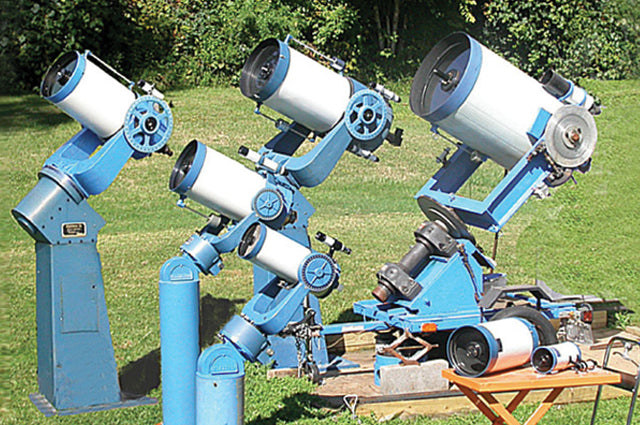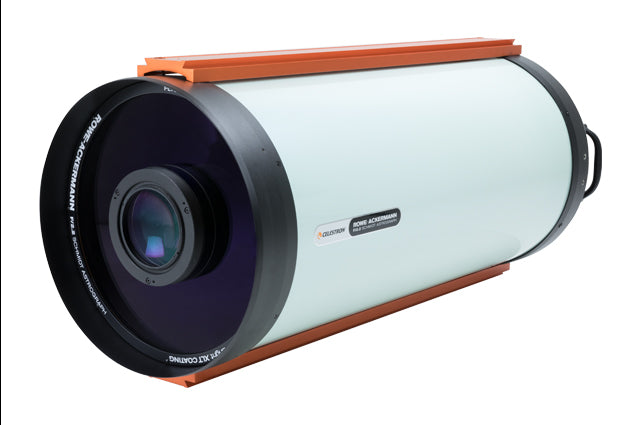Our Story

As the world’s number one telescope maker, Celestron employs nearly 100 people worldwide, including a robust product development team at our headquarters in Torrance, California. Optical and electronic engineers work closely with product managers and on-site manufacturing staff to produce groundbreaking new telescope technologies. But it wasn’t always this way. The company that would grow to become Celestron was born from a father’s desire to share astronomy with his young sons.
In the late 1950s, Tom Johnson worked as CEO and founder of Valor Electronics in Gardena, California. He was searching for a telescope to introduce his sons to the wonders of stargazing. When he couldn’t find one he liked, he built a 6” reflector from scratch. The project sparked Johnson’s interest in the hobby of telescope making. Over time, he began constructing larger and more complex instruments.
The 1960s

By 1960, Tom’s hobby had turned into a driving passion, one he wanted to incorporate into his business. So, he founded Celestron-Pacific as an astro-optical division of Valor Electronics—for the sole purpose of building telescopes.
In July 1962, Tom Johnson attended a star party hosted by the Los Angeles Astronomical Society on the summit of Mount Pinos. He brought along a “portable” 18 ¾” Cassegrain reflector he built from surplus parts. Attendees loved his telescope, and many asked if he would make more. Journalists from Sky & Telescope magazine noticed, too, placing Tom and his telescope on the cover of the March 1963 issue.

Next, Tom pivoted to the Schmidt-Cassegrain telescope (SCT) design, which incorporates features of both refractors and reflectors. The SCT offered many advantages—it was compact, easy to maintain, and could be constructed in large apertures for bright, detailed views.
Before Celestron-Pacific, SCTs existed, but they were rare and expensive, usually only used in scientific research. This was because each telescope had to be produced individually by master optical technicians who spent hours hand-figuring the Schmidt corrector lens.
Tom believed he could devise a method to mass-produce the SCT, making it more accessible and affordable. He achieved his goal by developing ultra-precise match plates, which he could use to shape optical glass into the complex figure of the Schmidt corrector lens at scale. Johnson’s technique allowed him to create telescopes of unparalleled quality and bring them to market at a surprisingly low price. To this day, Celestron manufactures our Schmidt correctors using match plates and Tom’s signature method.

In January 1964, Celestron-Pacific ran its first ad in Sky & Telescope magazine, introducing the Celestronic 20, a 20” SCT. Later that year, produced a 22” SCT and Pacific was dropped from the company’s name, and the brand that we know now, Celestron, was born.

By 1969, Celestron had expanded its line with an entire collection of Schmidt-Cassegrain telescopes for observatories and serious amateurs. These famous 6”, 8”, 10”, 12”, and 22” Celestron SCTs featured distinctive blue and white tubes.
The 1970s

In the 1970s, Celestron redefined the hobby of astronomy with its flagship Celestron 8, now with a new orange tube. Known simply as the “C8,” this iconic commercial-grade telescope packed 8 inches of aperture into a compact, lightweight package—with a price tag under $1,000.
 Customers flocked to the C8 in droves, making the product an instant smash success. Suddenly, casual observers around the world were viewing faint, deep-sky objects they’d only read about in books or viewed through large observatory telescopes. The C8’s popularity led the company to follow it up with an even more portable version, the C5 (a 5” SCT), in 1971.
Customers flocked to the C8 in droves, making the product an instant smash success. Suddenly, casual observers around the world were viewing faint, deep-sky objects they’d only read about in books or viewed through large observatory telescopes. The C8’s popularity led the company to follow it up with an even more portable version, the C5 (a 5” SCT), in 1971.
After revolutionizing visual astronomy, Celestron set its sights on the emerging field of astrophotography, releasing the Celestron-Williams Cold Camera in 1971. This astrophotography camera increased the speed of standard 35mm film by chilling it to sub-zero temperatures, allowing the film to capture more light in the same exposure time, revealing unseen details in distant galaxies and nebulae.
In 1972, the C14 joined the “orange tube” SCTs. The complete series included the C5, C6, C8, C10, C12, C14, C16, and C22.
The 1980s
In 1984, Celestron made another cosmetic change to the optical tubes, replacing the orange with a sleek black with orange accents. Today’s SCTs still feature variations on this color scheme.
Around the same time, Celestron introduced its revolutionary optical coating, StarBright XLT, which dramatically increases light transmission through the optical path to an astonishing 89 percent. We still use StarBright XLT coatings on our mid- to high-level telescopes and even binoculars.

The late 1980s ushered in the era of computerized or GoTo telescopes, which could automatically slew themselves to objects in the night sky. Celestron’s first GoTo telescope was the Compustar Computer-Controlled Telescope. Powered by an Intel 8052 microprocessor and equipped with a database of more than 8,000 astronomical objects, Compustar opened the hobby of astronomy to people without detailed knowledge of the night sky.
The 1990s

In the 1990s, two Celestron telescopes freed themselves from the bonds of Earth’s gravity. Celestron has been honored to provide telescopes for multiple NASA missions. The first was in 1992 when Space Shuttle Atlantis carried a C5 and a C8 into orbit. Two decades later, another group of astronauts installed a CPC 925

telescope in an Earth-facing window aboard the International Space Station. The CPC is still in use as part of NASA’s ISERV mission; it captures images of the Earth to monitor global weather patterns and aid in disaster relief.
The late 1990s ushered in a new era of innovations. The first was the Ultima 2000. Released in 1996, it was the first GoTo telescope to run on AA batteries.
On the astrophotography front, Celestron joined forces with Santa Barbara Instruments Group (SBIG) to meet the demand of astroimagers. Together, the two companies produced a revolutionary add-on to Schmidt-Cassegrain optical tubes, Fastar. It let users replace the secondary mirror at the front of the scope with an SLR, DSLR, or astronomical CCD camera. Imagers using Fastar could shoot at f/2, 28 times as fast as the telescope’s native focal ratio of f/10. Today, all Celestron SCTs are compatible with Fastar.
The 2000s
Between 2006 and 2009, Celestron enjoyed an era of explosive growth with several exciting—and award-winning—innovations.

The SkyScout Personal Planetarium, released in 2006, was a handheld device used alone or with a telescope. When users pointed SkyScout at an object in the night sky, it would instantly identify the object and provide scientific information about it. The database also included hundreds of audio descriptions for the most popular objects. The device flew off the shelves and accomplished its goal of demystifying astronomy for novice observers.
Hunching over a microscope eyepiece became a thing of the past in 2008 when Celestron debuted the LCD Digital Microscope. The instrument won a 2009 Innovation Award at the Consumer Electronics Show (CES).

Celestron ended the 2000s with a bang when it introduced EdgeHD technology in July 2009 at the Riverside Telescope Makers’ Conference, one of Celestron founder Tom Johnson’s last events. Building on the legacy of the SCT, EdgeHD is an aplanatic, flat-field Schmidt optical system that virtually eliminates the aberrations of field curvature and coma, producing pinpoint stars to the edge of the field of view of even the largest imaging sensors and wide-field eyepieces.
Also in 2009, to commemorate the International Year of Astronomy, Celestron was invited to the first White House Star Party. President and First Lady Obama took their turns at the eyepiece of a CPC 800 telescope.
The 2010s

In 2011, Celestron unveiled the first-ever self-aligning telescope, SkyProdigy. It was the first product to use Celestron’s patented StarSense technology to analyze star patterns overhead, compare them to an internal database like fingerprints, and align itself to the night sky. SkyProdigy used an internal camera and advanced software to align the telescope in under 3 minutes. The telescope received another Innovations Award at CES. Two years later, the StarSense AutoAlign accessory brought StarSense technology to every Celestron computerized telescope.
In 2014, Celestron reimagined the original C8 with modern technologies like built-in WiFi and lithium iron batteries. WIRED magazine hailed the NexStar Evolution WiFi Telescope as the “coolest app-cessory in the galaxy.”
 |

|
That same year, Celestron worked with optical engineers Dave Rowe and Mark Ackermann to release its first astrograph with native f/2.2 imaging capabilities. The Rowe-Ackermann Schmidt Astrograph (RASA) is ideal for imaging wide-field, deep-sky objects with DSLR and astronomical CCD cameras. In 2019, the RASA 8 and RASA 36 completed the RASA family.

In 2015, Celestron staff collaborated with physicist Stephen Hawking to create a custom CPC Deluxe 1100HD telescope that he could operate from his computer. The team traveled to Hawking’s home in Cambridge, UK, to install the telescope and help him capture his first astroimages.

Throughout the 2010s, several Celestron telescopes took their turns in the spotlight, making cameos on The Big Bang Theory, The Price is Right, Dexter, and New Girl. You can even spot Celestron telescopes in the Marvel Cinematic Universe; they were featured in Thor and Iron Man 3. To see where else Celestron has been, click here.
The 2020s and Beyond

In 2020, Celestron celebrated 60 years since Tom Johnson released his first commercial telescope. The team designed a special anniversary-edition NexStar Evolution 8HD to commemorate the milestone. Only 600 were made, each with a unique serial number and certificate of authenticity. They sold out within weeks.

That same year, Celestron unveiled a revolutionary entry-level telescope, StarSense Explorer. This manual telescope works with a proprietary smartphone app to analyze the night sky and calculate its position in real-time using StarSense Explorer technology. This empowers brand-new telescope owners with instant success and confidence. StarSense Explorer received an IHS Markit ShowStoppers CES 2020 Innovation Award and has since expanded to a complete lineup, including full-size and tabletop Dobsonians.

Just as the C8 redefined the hobby of astronomy in the 1970s, Celestron Origin, released in 2024, represents a new paradigm shift in visual observing and astroimaging. Celestron leadership first envisioned this all-in-one intelligent home observatory in the late 2000s, giving it the codename AMO (Automated Mobile Observatory). Their original vision, which predated the modern smartphone, was for an autonomous astroimaging system that delivered detailed astroimages directly to a computer or external screen. With the rise of more powerful smartphones in the early 2010s, the concept pivoted to a smartphone app-enabled experience.
To make Origin a reality, Celestron engineers embarked on a years-long development process, creating multiple patented technologies along the way. Each component was essential to make the system work—from the optical design to navigation to power. These technologies became iconic, standalone Celestron products in their own right: SkyProdigy, StarSense AutoAlign, the Rowe-Ackermann Schmidt Astrograph, the SkyPortal WiFi Module and SkyPortal Powered by SkySafari™ app, PowerTank Lithium, NexStar Evolution, the Celestron Focus Motor, Dew Heater Rings, and the Smart DewHeater Controller, just to name a few.
Celestron Origin combines all these technologies into a seamless experience that enables everyone to capture stunning images that rival those only professional imagers could capture just a few decades prior—even on their first night under the stars. More than any product before it, Origin delivers on Tom Johnson’s original mission of making astronomy accessible and fun, while transforming the observing experience for a new generation.
But the journey won’t stop here. Just as in decades past, Celestron’s engineers and leaders continue to dream up new ways to explore the universe and push the boundaries of technology. Stay tuned; there’s lots more yet to come.
